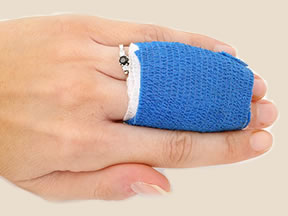Inflammation: Friend or Foe?
Should inflammation be reduced quickly or is it the necessary step in the healing process?
Inflammation: Friend or Foe?
The current gold standard of treatment for acute musculoskeletal injury is based on the concept that inflammation is bad and must be stopped before the healing can begin. The inflammation/swelling that occurs is significantly reduced using the R.I.C.E. method, which is an acronym used in sports medicine, which stands for:
Rest
Ice
Compression
Elevation
The philosophy is based on trying to decrease inflammation immediately after injury. Although I agree with reducing the quick onslaught of swelling that occurs right away, RICE should be used for only the first 24-48 hours in most cases. Continuing to reduce inflammation after this time is common and should be re-evaluated.
I argue that this method is not cohesive with our bodies natural healing response and the doing so may inhibit it and cause incomplete healing, bringing chronic pain and instability. I have seen numerous sports injuries that have not healed effectively after they have been treated for an extended period with the RICE method.

Why is Inflammation Important?
The inflammatory process brings blood flow to the area of injury and cellular debris/waste away. Although the inflammatory process may need to be subdued at times, we do not want to completely halt it because inflammation is an initial and necessary step in the healing process.
The normal healing response begins the moment the tissue is injured. As the blood components spill into the site of injury, the platelets come into contact with exposed collagen and other elements of the extracellular matrix. This contact triggers the platelets to release clotting factors as well as essential growth factors and cytokines such as platelet-derived growth factor (PDGF) and transforming growth factor beta (TGF-ß). Following hemostasis, the neutrophils then enter the wound site and begin the critical task of phagocytosis to remove foreign materials, bacteria and damaged tissue. As part of this inflammatory phase, the macrophages appear and continue the process of phagocytosis as well as releasing more PDGF and TGFß. Once the wound site is cleaned out, fibroblasts migrate in to begin the proliferative phase and deposit a new extracellular matrix. The new collagen matrix then becomes cross-linked and organized during the final remodeling phase.
During this proliferative phase, type I collagen is being laid down by the fibroblasts to increase ligament and tendon strength. After about four weeks, about 60 percent of the tensile strength of the tissue may be restored. This obviously depends on the amount of tissue damage and the ability to mount an inflammatory response after injury. The healthier the immune system, the quicker the ability to heal. Because the proliferative phase lasts about four to six weeks in most individuals, prolotherapy injections are given by most clinicians every four to six weeks.

